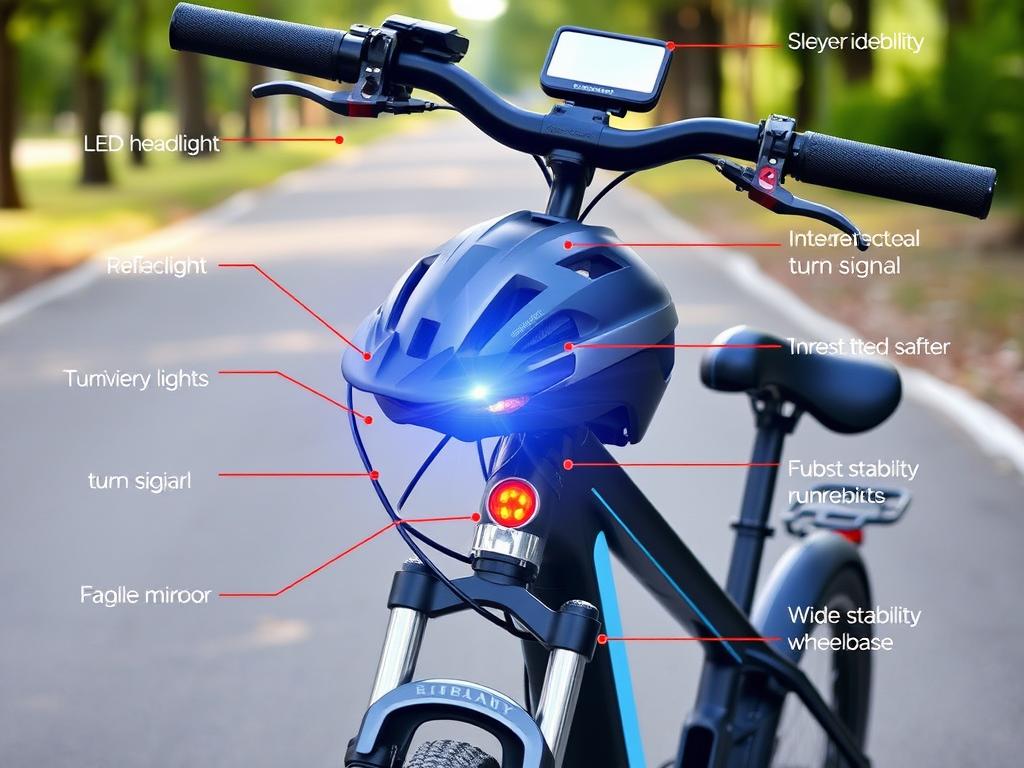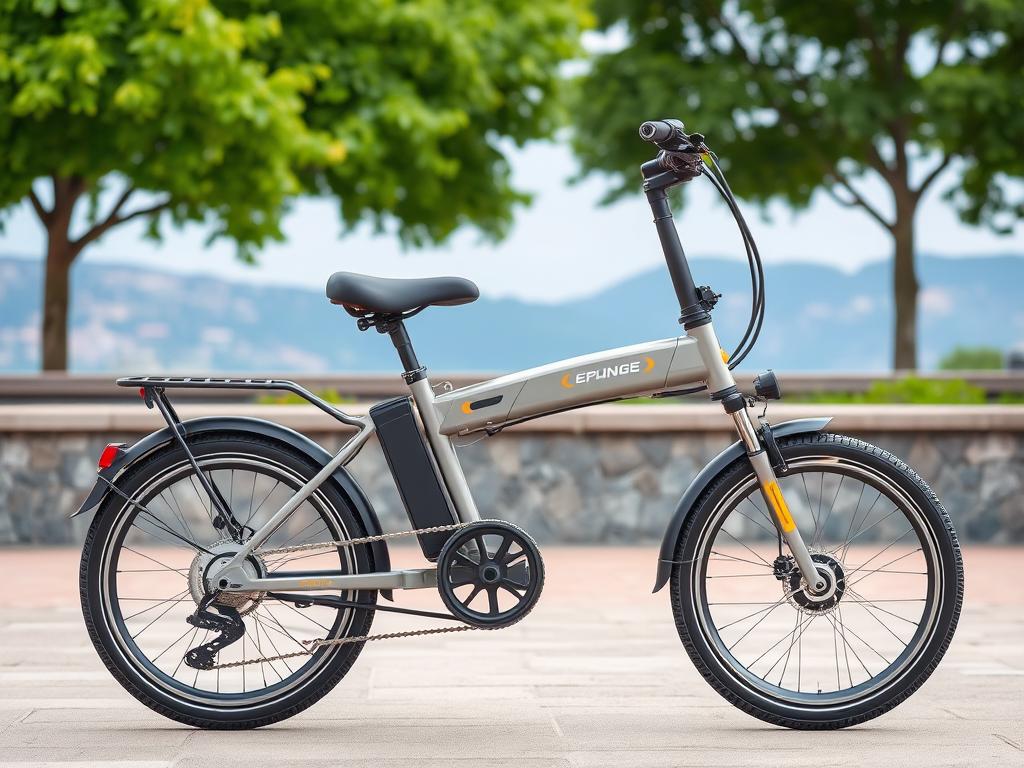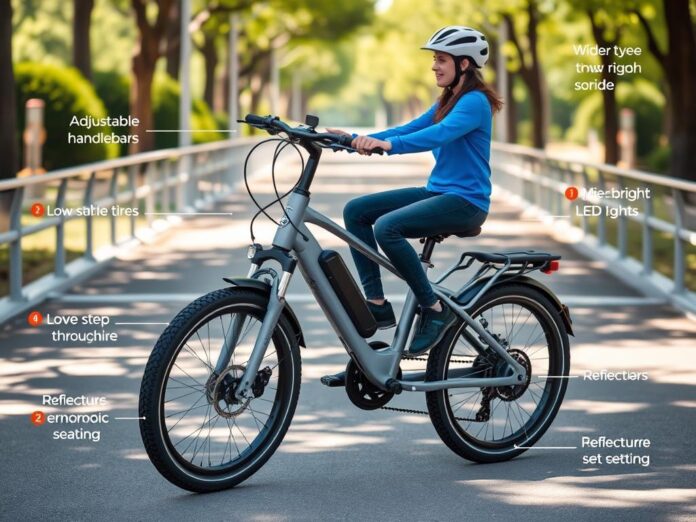In today’s world, staying active and independent is key. E-bikes have become a big help for those with limited mobility. They come with safety features that meet the needs of seniors and others with physical challenges. This lets them enjoy the outdoors with confidence and ease.
E-bikes are a great way to stay active. They mix pedal-assisted power with the freedom of regular cycling. Their low step-over height and better stability make them safer for older adults or those with mobility issues. This is because they reduce the risk of accidents when getting on and off.
Key Takeaways:
- E-bikes with low step-over heights reduce the risk of accidents during mounting and dismounting, making them a safer option for older adults or those with limited mobility.
- Step-thru e-bikes offer improved stability while stationary, crucial for preventing tip-overs in urban environments.
- E-bikes with advanced braking systems, such as hydraulic disc brakes, provide superior stopping power and modulation for enhanced safety.
- Adjustable components in e-bikes allow for a custom fit, promoting safer and more comfortable riding experiences for riders of different sizes.
- Battery safety features, including battery management systems and removable batteries, ensure safe operation of e-bikes under various conditions.
Understanding Limited Mobility and E-Bikes
Limited mobility means you can’t move as easily, often because of age, injury, or health issues. But e-bikes have changed the game for those with mobility issues. These electric bikes offer motor support, making it simpler to ride up hills, go longer distances, and overcome physical barriers.
What is Limited Mobility?
Limited mobility can show up in many ways, like less strength, stamina, balance, or flexibility. For many, biking becomes too hard, limiting their freedom and physical activity. E-bikes, with their stabilizers, anti-tip technology, and ergonomic design, help riders regain their mobility and freedom.
How E-Bikes Can Help
- Motor assistance: The electric motor in e-bikes helps, making pedaling easier, especially on hills or long rides.
- Increased range: E-bikes let riders go further without getting too tired, making it easier to run errands, visit friends, or explore.
- Improved stability: E-bikes often have wider tires and low step-through frames, making them more stable. This helps riders with mobility issues get on and off the bike more easily.
E-bikes help people with mobility issues stay independent and active. They offer motor support and safety features, making biking accessible again for those with physical limitations.
Key Safety Features for E-Bikes
Safety is key when it comes to e-bikes. These electric bikes are great for getting around and are good for the planet. But, they need special safety features, especially for those who have trouble moving around.
Stability Enhancements
E-bikes have a lower center of gravity and wider tires. This makes them more stable and easier to control. This is great for people who find it hard to balance or ride on bumpy paths. The extra weight and power of an e-bike also make it more stable, helping it handle better.
Visibility Improvements
Being seen is important for safety, especially when it’s dark. Many e-bikes have built-in lights like LED headlights and taillights. Some also have reflective parts to make riders more visible. These features help keep e-bike riders safe by making them easier to see.
Emergency Braking Systems
Good brakes are crucial for safe riding. E-bikes often have advanced brakes like hydraulic disc brakes. These work well in all kinds of weather. Some e-bikes even have special brake levers that stop the motor when you hit the brakes. This adds an extra safety feature in emergency stops.
| Feature | Class 1 | Class 2 | Class 3 |
|---|---|---|---|
| Maximum Assisted Speed | 20 mph | 20 mph | 28 mph |
| Throttle | No | Yes | No |
| Bike Lane Requirement | No | No | Yes |
| Minimum Rider Age | No minimum | No minimum | 16 years |
These safety features, along with learning how to ride and following the rules, make e-biking safer. Knowing about the different types of e-bikes helps riders choose the safest one for them. This way, everyone can enjoy riding e-bikes safely.

Importance of Adjustable Seating
Adjustable seating is key for e-bikes made for riders with limited mobility. Ergonomic designs help riders sit naturally, easing back and joint pain. Look for seats that are padded and adjustable, offering the right support for each rider. Seats with shock absorption make rides smoother on rough paths.
Getting the seating right helps riders pedal more efficiently. This makes riding safer and more enjoyable.
Ergonomic Designs
E-bikes focus on ergonomic designs for comfort and support. They have adjustable parts like handlebars, seats, and pedals. This helps riders with mobility issues or physical limitations.
The goal is to make riding easy and stress-free. It helps riders pedal better and stay safe.
Cushioning Options
- Padded, adjustable seats provide essential comfort and support for riders with limited mobility.
- Suspended seats with shock absorption enhance the riding experience by absorbing the impact of uneven surfaces.
- Customizable seat positions allow users to find the perfect fit, reducing strain on the back, hips, and legs.
| Feature | Benefit |
|---|---|
| Adjustable Seating | Promotes proper riding posture and reduces strain on the body |
| Shock-Absorbing Suspension | Enhances comfort and smooth riding experience on uneven surfaces |
| Customizable Seat Positioning | Allows for personalized fit to accommodate individual needs and preferences |

“E-bikes with adjustable, ergonomic seating provide a comfortable and safe riding experience, enabling riders with limited mobility to enjoy the benefits of cycling.”
Technology for Enhanced Safety
The electric bike (e-bike) world is getting smarter, thanks to new tech. This tech is making rides safer for everyone, especially those who find it hard to move around. [https://rizebikes.com/blogs/blog/innovations-in-e-bike-technology-what-to-expect-in-the-next-decade] These advanced features make riding better and safer, giving users more confidence and peace of mind.
Built-in Navigation Assistance
One big safety feature in e-bikes is built-in navigation. It uses GPS to help riders find easy routes. This avoids tough paths or steep hills that might be hard for some to handle. It makes riding smoother and safer, cutting down the chance of getting lost or hitting obstacles.
Smart Connectivity Features
E-bikes are also getting smarter with features that help riders. Some let you control your bike with your phone, check how it’s doing, and even get alerts if something goes wrong. Plus, GPS helps find your bike if it gets lost or stolen, making it safer for everyone.
These new safety features in e-bikes are a big help for riders who have trouble moving. They give riders more confidence and freedom on the road. Thanks to electric bike accessories and rider assistance tech, e-bikes are making cities more open and welcoming to everyone.
“The integration of GPS navigation and smart connectivity features in e-bikes has been a game-changer for riders with limited mobility. It’s like having a personal assistant guiding you and keeping you safe on every ride.”

Customization Options for Individual Needs
Customizing e-bikes is crucial for meeting individual needs. Mobility aids like adjustable handlebars are key. They help riders find the perfect position, easing strain on their wrists and arms.
Look for e-bikes that let you adjust handlebars for height and reach. This ensures a fit that’s just right for you.
Accessories can also boost an e-bike’s functionality and comfort. Features like baskets, racks, mirrors, and comfort add-ons make a big difference. Some e-bikes even come with stabilizers or anti-tip technology for better balance and safety.
This is especially helpful for riders with limited mobility or adaptive controls needs.
| Customization Feature | Benefits |
|---|---|
| Adjustable Handlebars | Optimal reach and comfort, reducing wrist and arm strain |
| Accessory Integration | Baskets, racks, mirrors, comfort add-ons, stabilizers, anti-tip technology |
| Specialized Seating | Ergonomic designs, cushioning options for enhanced comfort |
| Smart Technology | Built-in navigation, connectivity features for safety and convenience |
By customizing an e-bike to fit individual needs, riders can enjoy a better experience. This is true whether they have limited mobility or need adaptive controls.
“Adaptive bikes cater to diverse physical needs, including those of disabled individuals, paralyzed cyclists, and adults with disabilities.”
Best Practices for Safe Riding
As an e-bike user with limited mobility, your safety is key. Following best practices can lower the risk of accidents and injuries. Let’s look at some important steps for a safe and fun e-bike ride.
Wearing Proper Protective Gear
Always wear a helmet that fits right. A helmet can greatly reduce head injury risks in falls or crashes. Also, wear protective gloves, reflective clothes, and knee/elbow pads for more safety.
Following Traffic Rules
Learn the local traffic rules for e-bikes. Follow traffic signals, ride in bike lanes or paths, and stay alert. Keep a safe speed, especially in turns or intersections, to control your e-bike well.
Do pre-ride checks like checking tire pressure, brakes, and wheel security. Know your limits and take breaks to avoid getting tired. Staying hydrated and well-rested also helps keep you safe.
By focusing on safety and following best practices, you can enjoy your e-bike more. Remember, a safe ride is a successful ride.
Choosing the Right E-Bike
When picking an e-bike for limited mobility, focus on safety features. Look for e-bikes with step-through frames for easy mounting and dismounting. Also, choose models with strong disc brakes, built-in lights, and adjustable pedal assist for a better ride.
Evaluating Your Safety Needs
Think about the battery range and motor power you need. Make sure the e-bike is light enough for you to handle. This affects your balance and control. Look for bikes with a low center of gravity, wide tires, and adjustable seats and handlebars for a custom fit.
Recommended Models for Limited Mobility
Recommended e-bikes for those with limited mobility include the Pedego Boomerang Step-Thru, the Eunorau Fat-HD, and the Bakcou Mule 24″ Step-Thru Adventure Ebike. These bikes have easy designs, strong safety features, and options for customization. They offer a safe and comfortable ride for seniors and those with mobility issues.






